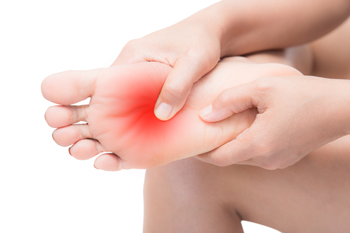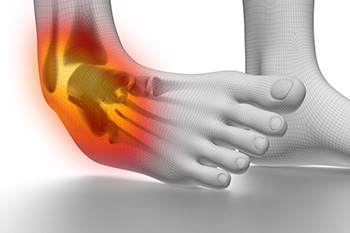January 2024
How to Recognize Charcot Foot

Charcot-Marie-Tooth, or CMT disease, is a genetic condition that affects the peripheral nerves. It can be recognized by progressive muscle weakness, particularly in the arms and legs. The condition is named after Jean Charcot, Pierre Marie, and Howard Henry Tooth, the physicians who first described it. Symptoms of Charcot foot often begin in adolescence or early adulthood and may include weakness and wasting of muscles in the foot and lower leg, as well as a loss of sensation in toes, and lower limbs. Additional symptoms can include abnormalities in foot muscles, unstable ankles, cramping in lower legs, and reduced reflexes. Over time, symptoms may worsen, leading to increased muscle and joint pain, neuropathic pain, and walking and mobility problems. Assistive devices, such as wheelchairs, leg braces, special shoes, or orthopedic devices, play an essential role in managing Charcot-Marie-Tooth disease. If you believe you may be experiencing symptoms of CMT, it is suggested that you schedule an appointment with a podiatrist for a comprehensive assessment and personalized care planning.
Some foot conditions may require additional professional care. If you have any concerns, contact Gregory Rorick, DPM of Rorick Podiatry, PC. Our doctor can provide the care you need to keep you pain-free and on your feet.
Rare Foot Conditions
The majority of foot conditions are common and can be treated by a podiatrist. Standard diagnostic procedures are generally used to identify specific conditions and treatment can be rendered. A podiatrist also treats rare foot conditions which can be difficult to diagnose and may need extra attention and care.
There are many rare foot conditions that can affect children. Some of these can include:
- Freiberg’s disease
- Kohler’s disease
- Maffucci syndrome
Freiberg’s disease - This can be seen as a deterioration and flattening of a metatarsal bone that exists in the ball of the foot. It typically affects pre-teen and teenage girls, but can affect anyone at any age. Symptoms that can accompany this can be swelling, stiffness, and the patient may limp.
Kohler’s disease - This often targets the bone in the arch of the foot and affects younger boys. It can lead to an interruption of the blood supply which ultimately can lead to bone deterioration. The patient may limp or experience tenderness, swelling, and redness.
Maffucci syndrome - This affects the long bones in a child’s foot leading to the development of abnormal bone lesions. They are benign growths and typically develop in early childhood and the bones may be susceptible to breaking.
A podiatrist can properly diagnose and treat all types of rare foot conditions. If your child is affected by any of these symptoms or conditions, please don’t hesitate to call our office so the correct treatment method can begin.
If you have any questions please feel free to contact our office located in New York Mills, Utica, NY . We offer the newest diagnostic tools and technology to treat your foot and ankle needs.
Achilles Tendon Injuries From Running

Experiencing Achilles tendon pain while running can be quite uncomfortable, and preventing injuries is essential. The Achilles tendon connects the major calf muscles, the gastrocnemius and soleus, to the back of the heel bone. When it is subjected to excessive stress, it tightens and is forced to work too hard. This can lead to irritation or inflammation, which is commonly referred to as Achilles tendinitis. Over time, scar tissue, which is less flexible than the tendon, can develop on it. If the inflamed Achilles tendon continues to endure stress, it may tear or rupture, resulting in an Achilles heel injury. To address Achilles pain during running, the first step is to stop running when you feel discomfort. It is important to rest and seek professional advice from a podiatrist to assess the condition of your lower leg. Continuing to run with Achilles pain can potentially worsen the injury. If you are experiencing Achilles pain from running, it is suggested that you schedule an appointment with a podiatrist for a proper diagnosis and treatment plan.
Achilles tendon injuries need immediate attention to avoid future complications. If you have any concerns, contact Gregory Rorick, DPM of Rorick Podiatry, PC. Our doctor can provide the care you need to keep you pain-free and on your feet.
What Is the Achilles Tendon?
The Achilles tendon is a tendon that connects the lower leg muscles and calf to the heel of the foot. It is the strongest tendon in the human body and is essential for making movement possible. Because this tendon is such an integral part of the body, any injuries to it can create immense difficulties and should immediately be presented to a doctor.
What Are the Symptoms of an Achilles Tendon Injury?
There are various types of injuries that can affect the Achilles tendon. The two most common injuries are Achilles tendinitis and ruptures of the tendon.
Achilles Tendinitis Symptoms
- Inflammation
- Dull to severe pain
- Increased blood flow to the tendon
- Thickening of the tendon
Rupture Symptoms
- Extreme pain and swelling in the foot
- Total immobility
Treatment and Prevention
Achilles tendon injuries are diagnosed by a thorough physical evaluation, which can include an MRI. Treatment involves rest, physical therapy, and in some cases, surgery. However, various preventative measures can be taken to avoid these injuries, such as:
- Thorough stretching of the tendon before and after exercise
- Strengthening exercises like calf raises, squats, leg curls, leg extensions, leg raises, lunges, and leg presses
If you have any questions please feel free to contact our office located in New York Mills, Utica, NY . We offer the newest diagnostic tools and technology to treat your foot and ankle needs.
Causes of Nerve Pain in the Feet

When too much pressure is applied to a nerve in the foot, it can lead to a pinched nerve. This disrupts the nerve's normal function and causes a range of symptoms, including weakness, numbness, tingling sensations, and pain. Tarsal tunnel syndrome is a common condition that can result in a pinched nerve in the foot. The tarsal tunnel is a narrow passage in the ankle through which the tibial nerve runs, providing sensation to the bottom of the foot. When this nerve becomes compressed, it leads to tarsal tunnel syndrome and may cause a pinched nerve in the foot. Morton's neuroma is another condition that can lead to a pinched nerve in the foot. This condition involves the growth of a benign tumor on a nerve, often occurring between the third and fourth toes, just before the arch. Morton's neuroma results from the thickening of nerve tissue leading to the toes. It results in pain radiating from the ball of the foot to the ankle or toes and can cause numbness, cramping, or tingling sensations. People with Morton’s neuroma may feel a sensation of standing on a fold in a sock or having a pebble in the shoe. If you experience symptoms such as numbness, tingling, pain, or discomfort in your feet, it is suggested that you make an appointment with a podiatrist for an exam and a diagnosis.
Neuropathy
Neuropathy can be a potentially serious condition, especially if it is left undiagnosed. If you have any concerns that you may be experiencing nerve loss in your feet, consult with Gregory Rorick, DPM from Rorick Podiatry, PC. Our doctor will assess your condition and provide you with quality foot and ankle treatment for neuropathy.
What Is Neuropathy?
Neuropathy is a condition that leads to damage to the nerves in the body. Peripheral neuropathy, or neuropathy that affects your peripheral nervous system, usually occurs in the feet. Neuropathy can be triggered by a number of different causes. Such causes include diabetes, infections, cancers, disorders, and toxic substances.
Symptoms of Neuropathy Include:
- Numbness
- Sensation loss
- Prickling and tingling sensations
- Throbbing, freezing, burning pains
- Muscle weakness
Those with diabetes are at serious risk due to being unable to feel an ulcer on their feet. Diabetics usually also suffer from poor blood circulation. This can lead to the wound not healing, infections occurring, and the limb may have to be amputated.
Treatment
To treat neuropathy in the foot, podiatrists will first diagnose the cause of the neuropathy. Figuring out the underlying cause of the neuropathy will allow the podiatrist to prescribe the best treatment, whether it be caused by diabetes, toxic substance exposure, infection, etc. If the nerve has not died, then it’s possible that sensation may be able to return to the foot.
Pain medication may be issued for pain. Electrical nerve stimulation can be used to stimulate nerves. If the neuropathy is caused from pressure on the nerves, then surgery may be necessary.
If you have any questions, please feel free to contact our office located in New York Mills, Utica, NY . We offer the newest diagnostic and treatment technologies for all your foot care needs.
Surgical Options for Arthritic Toe Pain

Surgery is often considered a last resort for treating toe arthritis, primarily due to potential post-surgical discomfort and an increased risk of infection. However, when other treatments for toe arthritis prove ineffective, various surgical procedures may be considered. One common surgical approach is a cheilectomy, which involves the removal of bone spurs that have formed around arthritic joints, particularly in the big toe. This procedure can help alleviate discomfort surrounding the joint and improve joint mobility. It is important to note that cheilectomy does not address the worn-out cartilage within the joint, and bone spurs may return in the future. Another option is arthroplasty, where joint surfaces are replaced with artificial joints. This procedure is typically recommended for older adults who are less physically active. Fusion surgery stimulates bone growth across the joint, permanently fusing it using pins, screws, or a plate. While this eliminates joint flexibility, it also relieves pain. If you have persistent arthritic toe pain that has not responded to more conservative treatments, it is suggested that you visit a podiatrist to discuss how you may benefit from surgical options.
Toe pain can disrupt your daily activities. If you have any concerns, contact Gregory Rorick, DPM of Rorick Podiatry, PC. Our doctor can provide the care you need to keep you pain-free and on your feet.
What Causes Toe Pain?
Most severe toe pain is caused due to a sports injury, trauma from dropping something heavy on the toe, or bumping into something rigid. Other problems can develop over time for various reasons.
Toe pain can be caused by one or more ailments. The most common include:
- Trauma
- Sports injury
- Wearing shoes that are too tight
- Arthritis
- Gout
- Corns and calluses
- Hammertoe
- Bunions
- Blisters
- Ingrown toenails
- Sprains
- Fractures (broken bones)
- Dislocations
When to See a Podiatrist
- Severe pain
- Persistent pain that lasts more than a week
- Signs of infection
- Continued swelling
- Pain that prevents walking
Diagnosis
In many cases the cause of toe pain is obvious, but in others, a podiatrist may want to use more advanced methods to determine the problem. These can range from simple visual inspections and sensation tests to X-rays and MRI scans. Prior medical history, family medical history, and any recent physical traumatic events will all be taken into consideration for a proper diagnosis.
Treatment
Treatments for toe pain and injuries vary and may include shoe inserts, padding, taping, medicines, injections, and in some cases, surgery. If you believe that you have broken a toe, please see a podiatrist as soon as possible.
If you have any questions please feel free to contact our office located in New York Mills, Utica, NY . We offer the newest diagnostic tools and technology to treat your foot and ankle needs.
Plantar Warts Can Be Treated!
Symptoms and Causes of Ankle Sprains

An ankle sprain occurs when the ligaments that support the ankle are stretched or torn. This type of sprain is a common injury, constituting 25 percent of all sports-related injuries. Ankle sprains can affect anyone, not just those engaged in sports. While they are often caused by activities such as running and walking, they also can be the result of missteps on uneven surfaces, such as stepping into a hole or missing a curb. Symptoms vary in severity, and include pain, soreness, swelling, difficulty bearing weight or walking, and bruising. Diagnosis involves a comprehensive examination by a podiatrist, who can evaluate bones, soft tissues, range of motion, and strength. In some cases, imaging studies like X-rays may be ordered to rule out additional injuries, such as a fracture. Timely and proper treatment typically takes between four and six weeks, depending on severity. Acknowledging the causes and symptoms of ankle sprains is important for prompt intervention, ensuring optimal recovery and minimizing the risk of future complications arising from these common injuries. If you have endured an ankle sprain, it is suggested that you schedule an immediate appointment with a podiatrist for an exam and treatment.
Ankle sprains are common but need immediate attention. If you need your feet checked, contact Gregory Rorick, DPM from Rorick Podiatry, PC. Our doctor can provide the care you need to keep you pain-free and on your feet.
How Does an Ankle Sprain Occur?
Ankle sprains take place when the ligaments in your ankle are torn or stretched beyond their limits. There are multiple ways that the ankle can become injured, including twisting or rolling over onto your ankle, putting undue stress on it, or causing trauma to the ankle itself.
What Are the Symptoms?
- Mild to moderate bruising
- Limited mobility
- Swelling
- Discoloration of the skin (depending on severity)
Preventing a Sprain
- Wearing appropriate shoes for the occasion
- Stretching before exercises and sports
- Knowing your limits
Treatment of a Sprain
Treatment of a sprain depends on the severity. Many times, people are told to rest and remain off their feet completely, while others are given an air cast. If the sprain is very severe, surgery may be required.
If you have suffered an ankle sprain previously, you may want to consider additional support such as a brace and regular exercises to strengthen the ankle.
If you have any questions please feel free to contact our office located in New York Mills, Utica, NY . We offer the newest diagnostic and treatment technologies for all your foot and ankle needs.










